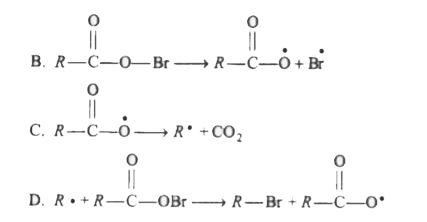Free radicals can undergo
rearrangement to a more stable free radical
decomposition to give another free radical
combination with other free radical
all are correct
The correct Answer is:D
Step-by-Step Solution:
1. Understanding Free Radicals:
Free radicals are species that contain an unpaired electron. They are highly reactive due to their electron deficiency.
2. Analyzing the Options:
- Option A: Rearrangement to form a more stable free radical.
Free radicals do not undergo rearrangement like carbocations do. Therefore, this option is incorrect.
- Option B: Decomposition to give another free radical.
Free radicals do not typically decompose to form other free radicals. This option is also incorrect.
- Option C: Combination with other free radicals.
Free radicals can combine with other free radicals. This occurs through the sharing of their unpaired electrons, leading to the formation of a covalent bond. This option is correct.
- Option D: All are correct.
Since options A and B are incorrect, this option is also incorrect.
3. Conclusion:
The only correct statement about the behavior of free radicals is that they can combine with other free radicals. Therefore, the correct answer is Option C.
Final Answer:
Free radicals can undergo combination with other free radicals.
---
Free radicals are species that contain an unpaired electron. They are highly reactive due to their electron deficiency.
- Option A: Rearrangement to form a more stable free radical.
Free radicals do not undergo rearrangement like carbocations do. Therefore, this option is incorrect.
Free radicals do not typically decompose to form other free radicals. This option is also incorrect.
Free radicals can combine with other free radicals. This occurs through the sharing of their unpaired electrons, leading to the formation of a covalent bond. This option is correct.
Since options A and B are incorrect, this option is also incorrect.
The only correct statement about the behavior of free radicals is that they can combine with other free radicals. Therefore, the correct answer is Option C.
Free radicals can undergo combination with other free radicals.
Topper's Solved these Questions
- ORGANIC CHEMISTRY-SOME BASIC PRINCIPLES AND TECHNIQUES BOOK - NCERT FINGERTPS ENGLISHCHAPTER - ORGANIC CHEMISTRY-SOME BASIC PRINCIPLES AND TECHNIQUES EXERCISE - Exemplar Problems
12 Videos
- ORGANIC CHEMISTRY-SOME BASIC PRINCIPLES AND TECHNIQUES BOOK - NCERT FINGERTPS ENGLISHCHAPTER - ORGANIC CHEMISTRY-SOME BASIC PRINCIPLES AND TECHNIQUES EXERCISE - Assertion & Reason
13 Videos
- HYDROGEN BOOK - NCERT FINGERTPS ENGLISHCHAPTER - HYDROGEN EXERCISE - Assertion And Reason
15 Videos
- PRACTICE PAPER 1BOOK - NCERT FINGERTPS ENGLISHCHAPTER - PRACTICE PAPER 1EXERCISE - Practice Paper 1
44 Videos
Similar Questions
Free radicals and carbenes act as .......... philic reagents.
View SolutionAn organic reaction occurs by using reagents called electrophiles and nucleophiles via the formation of some reactive intermediates called carbocations, carbanions, free radicals, carbenes, nitrenes, radical cations, and radical anions.
The most stable free radical is :
View Solution
Knowledge Check
In which cases, free radicals can be formed by homolytic fission?
AH3C−O∣∣C−CH3hv−−→BR−N=N−Rhv−−→C DCH3−O−O−CH3hv−−→
DCH3−O−O−CH3hv−−→Which of the following is the free radical chain reaction?
A2CH3I+2Na→CH3−CH3+2NalBCH4+Cl2hv−−→CH3Cl+HClC DAll of the above
DAll of the aboveThe Hunsdiecker reaction is believed to proceed by a free radical mechanism and involves the formation of an acyl hypohalite.


The major product is :APh−CH=CH−−∣CH3BrBPh−Br∣CH−CH=CH−CH3CPh−CH=Br∣C−CH2−CH3DP−CH=CH−C∣CH3H−CH2Br
Why do free radicals and carbenes act as electrophiles ?
View SolutionArrange the following free radicals in decreasing order of stability:

View SolutionAn organic reaction occurs by using reagents called electrophiles and nucleophiles via the formation of some reactive intermediates called carbocations, carbanions, free radicals, carbenes, nitrenes, radical cations, and radical anions.
The most stable carbocation is :
View SolutionAn organic reaction occurs by using reagents called electrophiles and nucleophiles via the formation of some reactive intermediates called carbocations, carbanions, free radicals, carbenes, nitrenes, radical cations, and radical anions.
The most stable carbanion is :
View SolutionAn organic reaction occurs by using reagents called electrophiles and nucleophiles via the formation of some reactive intermediates called carbocations, carbanions, free radicals, carbenes, nitrenes, radical cations, and radical anions.
The least stable carbocation is :
View Solution
